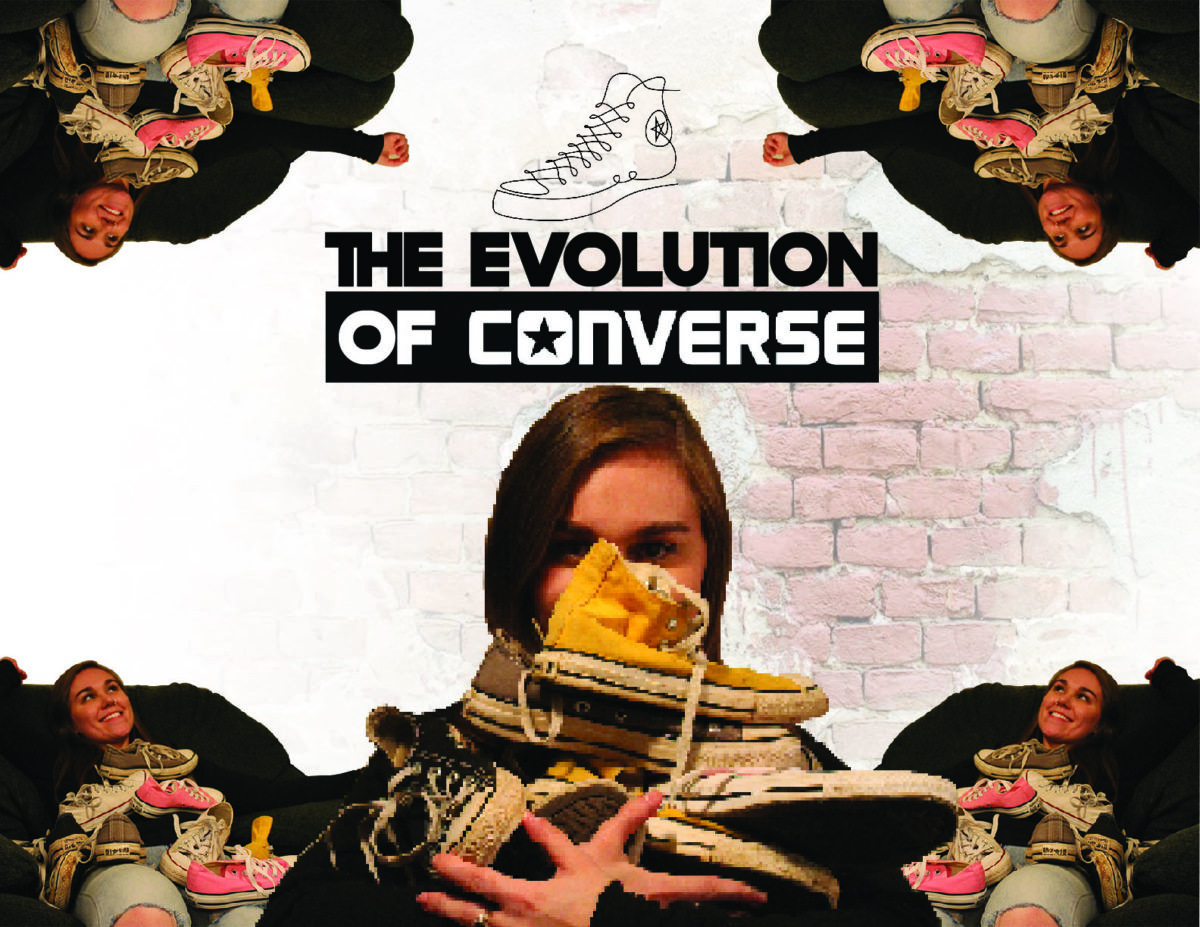

I remember purchasing my first pair of Chuck Taylor Converse All-Stars. I, a seventh-grade pop-punk-obsessed kid, had begged my mom for months to buy me a pair. I had never been more happy to walk into a Foot Locker in my life (and probably never will be again, let’s be honest).
A pair of black high-tops stole my heart. Cool, clean and classic. I imagined myself shredding guitar riffs on a Warped Tour stage in those things. I saw myself as the newest guest on Wayne’s World, stupidly bobbing my head with Mike Myers and Dana Carvey. I could feel Nirvana and the essence of every anti-hero to ever exist coursing through my veins.
My love for those canvas and rubber shoes didn’t stop there. As I’m writing this, I own eight pairs. They’re a staple in my own wardrobe and how others perceive me. More than anything, they’re like a comfort food or security blanket.
The shoes have been present in the closets of the uncool for 100 years. When the Converse Rubber Corporation opened for business in 1908, it only made work-related rubber shoes on a seasonal basis. But eventually, the bosses decided they wanted to keep employees working year-round.
By 1917, sneaker-producers found themselves in a similar situation they would find today. With the growing popularity of basketball, there were big opportunities. After much research and development, the All-Star shoe was crafted. The original was a natural brown colour, ankle-high, with a thick black rubber sole and trim, later gravitating towards all-black canvas and leather versions in the ‘20s. The All-Star was to be the first mass-produced basketball shoe in North America.
Sales were slow until our friend Chuck H. Taylor swooped in. He had worn them as a high school student since the beginning. In 1923, Taylor went to the company’s sales office in Chicago looking for a job.
Within a year, Taylor provided suggestions that would lead to enhanced flexibility and support, as well as including the recognizable patch to protect the ankle. By 1932, his name was added to the patch.
Within time, the shoe, in all its variations, has become much more than a secret weapon for making jump shots. It’s morphed into an icon, inviting consumers from all walks of life to purchase a device for self-expression and individuality.

The appeal
For most people, myself included, the love for Converse comes from two factors: coolness and comfort.
Converse are both casual and unique enough to keep you comfortable yet fashionable no matter what you’re doing or where you’re going. But what has kept consumers coming back to the shoe for so many years is no longer simply athleticism. It’s the so-uncool-you’re-cool essence Converse give off that everybody is after.
My love for Converse was born out of watching my favourite rockstars strut the stage in the canvas shoes and my favourite underdog movie characters running through the dirt with the rubber protecting their tired feet.
Second-year student Johnny Matheson can often be seen wearing his beloved red Chucks. Full of holes, he says he likes them too much to throw them out and get a new pair.
He’s even found a knee-high pair which surprisingly adds to the comfort.
“That’s why I like Converse, because they are stylish and comfy,” Matheson says.
“I like the vintage look that Converse give off, and the high tops cover for when my pants are too short. The flat bottoms are comfortable because it just feels like I’m walking barefoot.”
Matheson says when he sees others wearing Converse, there’s a sense of community because of the rivalry between those who wear Vans skate shoes and Converse.
“They have become so popular that they are a staple for shoes these days, but I don’t think that diminishes them at all,” he says.
“They are a safe choice that can go with any outfit and they come in so many different colours that they are easy to coordinate with them.”
Whether it be jeans and a t-shirt or a button-down dress shirt under a vest, there’s no denying the versatility of Converse.


I wore black low-tops to my final Grade 8 dance, and I even wore them to my actual high school prom and graduation. It was a testament to a lot of things: my reputation for being a little spitfire, not wanting my feet to die in six-inch heels, but most of all it was wanting to stay true to myself.
The trend
Shoes are just as much of an expression for me as my leather jacket or how I do my makeup. But over the last few years, as Converse grows in its sales, the shoe is showing up on more people’s feet than mine and my fellow anti-heroes.
White Converse especially have become a basic teenage girl wardrobe staple over the last two years. While I’m still not sure why, I do know that I bought mine because C. Thomas Howell wore them as Ponyboy in the film adaptation of The Outsiders. I’ve always been an rascal. A greaser. Maybe a nerd, but a proud one at that, and I feel as though Converse allows me to own it.
Third-year student Samantha Jesso is my kind of gal. She’s worn Converse since fourth grade. Like Matheson, she loves the comfort and diversity of the shoe.


But she says when she sees someone wearing Converse now, she doesn’t see a laid-back, easy-going person like many might think. She just sees another fad.
“Everyone made fun of them [as a kid] for being ugly, but now it is a new trend,” she says.
“I usually see girls wearing the white ones and I think, ‘They are going to get messy real quick.’”
Jesso says the uncool-yet-cool essence has taken a slight turn towards a hipster feel now that they’ve become so overwhelmingly popular.
“I think the trend of Converse is kind of a mockery just because the people I see wearing them back home especially are the people I know who would never have put sneakers in general on their feet before,” she says.
“I think people are just buying them to say they have the white canvas shoes with the red stripe on the side rather than for comfort or just love of the shoe.”
But Matheson says its popularity only strengthens evidence the shoe’s style is timeless.
“Their popularity has passed the point of fad and have installed them as a good footwear choice for decades to come.”
The culture
In 2003, Converse’s 95th anniversary, Nike Inc. bought the world-renowned shoe company for $305-million USD. At that time, Converse was generating annual sales of just over $200-million.
Fast forward to 2017, the shoe’s sales have ballooned to nearly $2-billion — a 19 per cent growth per year.
Converse sells more than 270,000 pairs of Chuck Taylors every day, which is about three pairs per second or around 100-million a year.
Those figures came from Geoff Cottrill, vice president and general manager of Converse. He mentioned the massive sales in a conversation with the New York Times on the launch of the Converse Chuck Taylor 2 in 2015, a redesign with improved comfort and Nike sole technology.
Some experts say this upward trend in sales has been for a number of reasons: better distribution in the U.S. and Europe, crackdown on knock-offs — the usual suspects. But the growth of sneaker culture and athleisure are likely culprits as well.
That growth has trickled down into secondary markets, booming ones driven by millennial demand and strategic business moves. Sports shoes are “expected to have the largest market in terms of volume globally from 2014 to 2020,” according to PR Newswire. Transparency Market Research says it expects the global footwear market to reach $220.2-billion in value by then.
Chuck H. Taylor and his friends pioneered the celebrity endorsement. With a classic vibe and being on the more affordable end of the spectrum, Converse set marketing standards in the world of athletic footwear we can’t resist even today.
The legacy
Sometimes, being the Converse snob that I am, I’m hesitant to reach for my favourite shoes. The piece that once made me feel so unique, so powerful, so proud to be who I am has now blended in with every other fashion choice my classmates are making.


But when I look at them, I get it. I get why that insecure, weird, music-loving seventh grader reached for them. They’re nostalgic for what I wanted to be and now they’re nostalgic for who I’ve always been.
And guess what? They’re not going anywhere.
As the shoe continues to sell like hot cakes, one thing remains the same: we’re all uncool. We’re all kids looking for something to make us feel the way I felt that day in Foot Locker, and if it means buying a pair of Converse, or any other piece of clothing, to bring that confidence out in us, who am I to judge?
